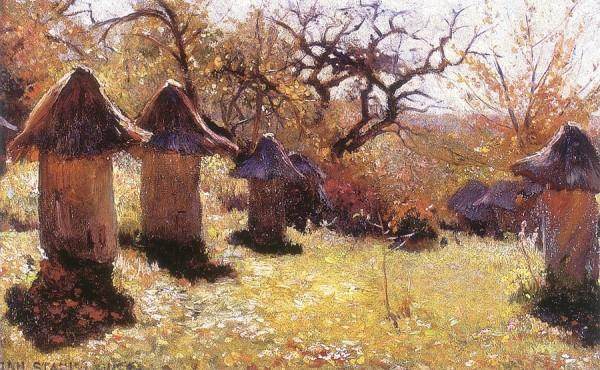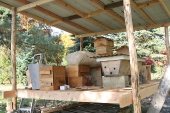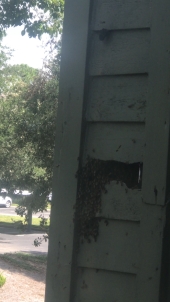
 3
3




Cj Verde wrote:I think the issue is that if you don't harvest the honey, the bees run out of space to make more bees and if that happens the bees will swarm.
 4
4




Moderator, Treatment Free Beekeepers group on Facebook.
https://www.facebook.com/groups/treatmentfreebeekeepers/









The instructor for this workshop explained that in harvesting these hives you have to cut the comb from the side of the log (as there are no frames to remove). You then can use an extruder designed for comb to extract the honey. You harvest a super to leave the rest of the hive in tact.
What we learn to do, we learn by doing.-Aristotle
 7
7








My Goofy T-Shirts: https://www.etsy.com/shop/4WardCo
 2
2




John Merrifield wrote:Did you see or do you know if any of the log-hive designs incorporated sloping walls inside the "honey super" log similar to the slope of the interior of top-bar hives?
 2
2




Moderator, Treatment Free Beekeepers group on Facebook.
https://www.facebook.com/groups/treatmentfreebeekeepers/









justus bernhard wrote:dear zach!
there is nothing new and nothing invented by sepp holzer published by this topic!
log hives are used since hundreds of years in beekeeping and they were the first step in developing the "modern bee hives".
when you are using pictures, please publish them under the correct references.
the pictures showing the vertical log hive, its' building and the observation hive are not sepp holzers origin.
the pictures are showing my beehives in my place in the austrian alps and I'm not sepp holzer - you know.
yours thomas.
 5
5




 2
2




Elevation: 88'
Avg. annual rainfall:48.26"
Avg. days of sunshine: 209
Humid subtropical climate (Köppen Cfb)
Rolling Coastal Plain








What we learn to do, we learn by doing.-Aristotle




Elevation: 88'
Avg. annual rainfall:48.26"
Avg. days of sunshine: 209
Humid subtropical climate (Köppen Cfb)
Rolling Coastal Plain
 2
2




What we learn to do, we learn by doing.-Aristotle
 1
1




 1
1




What we learn to do, we learn by doing.-Aristotle
 1
1




 4
4




Moderator, Treatment Free Beekeepers group on Facebook.
https://www.facebook.com/groups/treatmentfreebeekeepers/





 3
3




Live lightly, go quietly.
 1
1




 2
2




pato van ostra wrote:I've got access to a huge log - probably 4'diameter w/ 2' inner diameter. Thinking this would be too large to make the 'supers' but it would make a really cool mushroom hive like the Russians make. Or possible insect hotel? I'm looking for some good ideas to make use of it before it rots away. Was a great big tree that got cut to put in powerlines.
Moderator, Treatment Free Beekeepers group on Facebook.
https://www.facebook.com/groups/treatmentfreebeekeepers/






 2
2




Hans Albert Quistorff, LMT projects on permies Hans Massage Qberry Farm magnet therapy gmail hquistorff




Michael Cox wrote:
Sounds ideal for log hives. I wouldn't worry about adding supers to it, just chop it in sections that give about 60 liters volume and put and piece of wood on each end. If you can lift the sections off the ground they will last longer.
They can just be homes for feral hives, and you can easily add a caught swarm to one.
 1
1




Cj Sloane wrote:
Zach Weiss wrote:Never chisel towards yourself, unless your the son of a timber framer
I'm not so sure that even the son of a timber framer should wear sandals while chainsawing.
 2
2




 1
1




Earl Mardle wrote: ... shorts, bare hands, no face or EAR protection and similarly unprotected people holding the log.




 2
2




 We have also been listening to this podcast which is very helpful on the subject... https://podcasts.apple.com/us/podcast/arboreal-apiculture-salon/id1488314475
We have also been listening to this podcast which is very helpful on the subject... https://podcasts.apple.com/us/podcast/arboreal-apiculture-salon/id1488314475



Cat Lightfoot wrote:We recently found a hollow log and are excited to get it set up as a natural hive
We have also been listening to this podcast which is very helpful on the subject... https://podcasts.apple.com/us/podcast/arboreal-apiculture-salon/id1488314475




 2
2










|
The human mind is a dangerous plaything. This tiny ad is pretty safe:
Giant Log Stairs with Mike Haasl - Movie
https://permies.com/wiki/248235/Giant-Log-Stairs-Mike-Haasl
|








